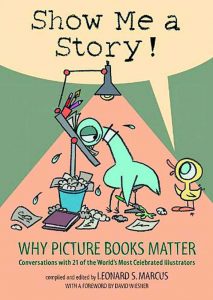Show Me a Story!
 Show Me a Story! Why Picture Books Matter: Conversations with 21 of the World’s Most Celebrated Illustrators, by Leonard S. Marcus. Published by Candlewick Press, 2012, 293 pp.
Show Me a Story! Why Picture Books Matter: Conversations with 21 of the World’s Most Celebrated Illustrators, by Leonard S. Marcus. Published by Candlewick Press, 2012, 293 pp.
With the publication of Show Me a Story: Why Picture Books Matter, Leonard S. Marcus again demonstrates that he is not only the foremost authority on the history and legacy of children’s books but also one of its most ardent advocates.
Originally published as Ways of Telling in 2002, this new edition enlarges and expands on the original interviews. For example, we not only hear about Jerry PInkney’s Philadelphia upbringing and how he made his way into picture books, but we also receive an update from an interview conducted in June 2011, on the eve of the largest exhibition of his art to date. Witnessing a conversation where Pinkney explains what pieces were included and why gives the picture book fan unparalleled access.
Joining Pinkney as interview subjects are 20 additional celebrated illustrators ranging from Anno to Zwerger, from Carle to Raschka, From Heo to Sis. Carle’s interview is one of the most rewarding–born in Syracuse and then raised in Germany during WWII, his journey to picture books was circuitous and fascinating. He studied with one of the leading European designers and was admitted to art school at an absurdly young age. Those of us familiar with the almost grandfatherly figure of Carle see him in a new light–as a hotshot prodigy who was forced to learn his craft but was the better for it.
An underlying theme of Show Me a Story is that art is valuable in every sense of the word. Someone at some point helped each of these artists find their style, discover their voice, and perhaps most appropriately, learn their line.
For Quentin Blake and James Marshall, the seeming energy and effortless of that line is revealed to be both planned and spontaneous. For Lisbeth Zwerger, Chris Raschka and many others, they find watercolor to be the medium that best expresses the story they have to tell. Helen Oxenbury and Tana Hoban had a vision that required rethinking the actual structure of a book to create something special for the very young.
Beyond the insights into the development of techniques and aesthetics, Show Me a Story also provides a number of anecdotes that give insights into the artists’ personal lives. Marcus does not shy away from the questions we might want to ask. So how did Maurice Sendak really feel about Wild Things dolls? It turns out that he was thrilled with the idea and even helped design the dolls. James Marshall started doodling to relieve the stress of teaching high school Spanish. The clever Marshall (who knew French, but no Spanish) worked out a deal with his Latino students to help him learn their language and help him keep his job. If you want to know how, you’ll just have to read the book.
Perhaps the most fascinating revelation about the nature of art comes in the interview with Anno. The Japanese master taught art to children at one stage of his career. He had planned a lesson where the children would go into a field of wheat and draw what they saw. Sadly, it was raining that day so instead, the artist brought in one stalk of wheat and showed it to his class, explaining that the field outside was made up of many stalks of wheat. The children then extrapolated the field from the single stalk for their drawings. The next day, another class was able to visit the field but their drawings were made up of so many lines that they were almost solid black. The children who really saw the stalk were able to more accurately portray the field, even though they never saw it. The abstract idea of a field was revealed.
The making of picture books seems like magic, but even when we are shown the man behind the curtain, the sorcery is not only still there, but it is magnified. Yet, art must be nurtured. There needs to be someone in a young person’s life to affirm a talent or point to another way of seeing. Show Me a Story underscores the importance of art education and demonstrates the lasting value of picture books. I like to think that it is a secret wish of those engaged in the world of creating children’s books to be the subject of a book by Leonard S. Marcus. Such attention would not only mean that you had arrived, but that you have stayed, and that your work is of lasting importance.
– Reviewed by Ellen Myrick
